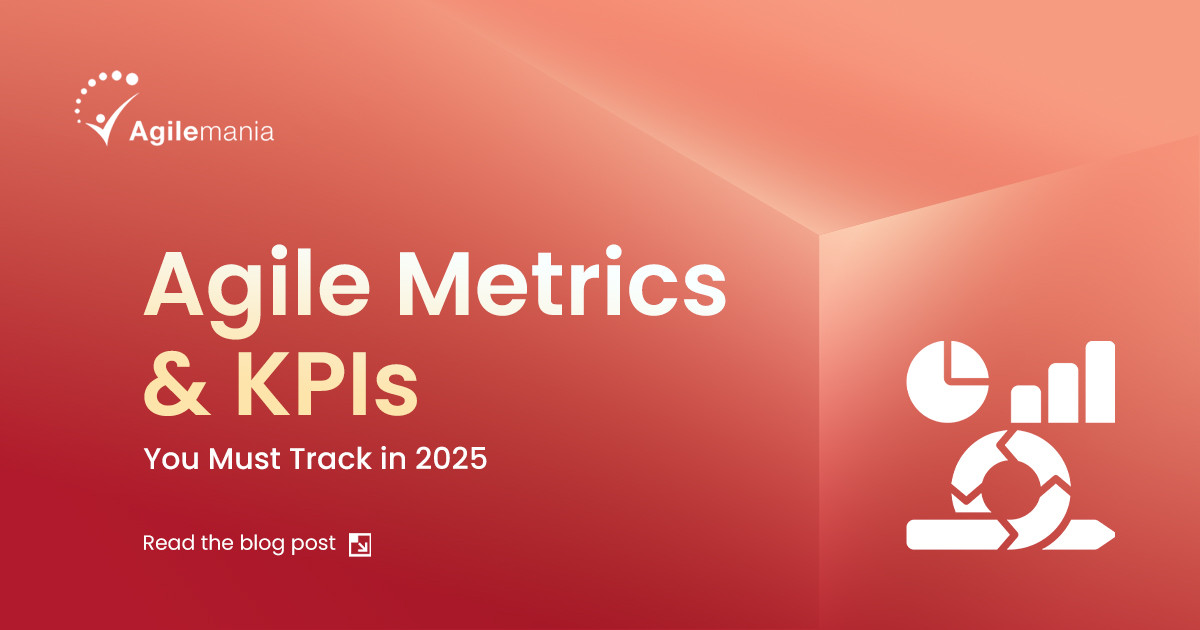
Sumeet Madan
With a remarkable 18-year tenure in software engineering, agile training, coaching, and consulting,... Read more
![]() Get Your AI-Enabled Scrum Master Certification for Just ₹1,500 (Save 85%)!
Get Your AI-Enabled Scrum Master Certification for Just ₹1,500 (Save 85%)!
Scrum.Org
SAFe®
ICAgile
Scrum Alliance
Technical Agility
Kanban
Business Analysis
Project Management
AI-Enabled
Scrum.Org
SAFe®
ICAgile
Scrum Alliance
Technical Agility
Kanban
Business Analysis
Project Management
AI-Enabled

Sumeet Madan
With a remarkable 18-year tenure in software engineering, agile training, coaching, and consulting,... Read more

Whether your team is launching a new product, updating existing features, or undergoing an Agile transformation, tracking performance is essential. That’s where Agile metrics and KPIs come in—they are your team’s North Star.
Agile metrics and KPIs give you real-time insights into your team’s progress and highlight potential roadblocks before they can throw your project off course. They aren’t just numbers—they're tools that help you understand what’s working and what needs adjustment.
In this blog, we’ll dive into 13 Agile metrics and KPIs you need to monitor in 2025 to ensure your projects stay on track and deliver the best results. Plus, we’ll show you how ClickUp can simplify tracking these key metrics.
Agile metrics are measurable data points that help assess your team’s progress, performance, and effectiveness. They give you real-time insights into whether your Agile processes are on track and whether you're delivering value. These metrics can be both quantitative (like how many tasks are completed) and qualitative (such as customer satisfaction).
Agile metrics vary depending on the type of Agile framework used. For instance, Scrum teams often track metrics like sprint burndown (remaining work in a sprint) and velocity (how much work a team completes per sprint). For Kanban teams, metrics like throughput (tasks completed in a specific period) and work-in-progress (WIP) are key.
Ultimately, Agile metrics help answer critical questions like: Are your iterations adding value? And is your product improving over time? These insights allow teams to refine their processes, deliver better products, and ensure they’re meeting project goals efficiently.
Agile Key Performance Indicators (KPIs) are a subset of Agile metrics, focusing on the most critical success factors in your Agile projects. While Agile metrics offer a broader view, KPIs are goal-aligned indicators that measure outcomes crucial to project success.
KPIs track things like sprint efficiency, product quality, and alignment with client goals. They are typically outcome-oriented, monitoring overall project health. Some common Agile KPIs include velocity, lead time, and defect escape rate, which offer a direct view of how well the project is progressing.
In short, Agile KPIs are selective metrics that help project managers identify risks, monitor performance, and ensure that the project delivers the desired outcomes within the set timelines. These indicators are essential for keeping Agile projects on track and driving continuous improvement.
Tracking Agile metrics and KPIs offers many benefits that can transform how your team operates, improves processes, and delivers value.
Metrics like cycle time (the average time to complete a task) and work in progress (WIP) highlight where your team might be slowing down or overworked. With this insight, you can redistribute tasks or adjust workflows to keep things moving smoothly. This approach is especially helpful when managing complex projects or tight deadlines, preventing bottlenecks from derailing progress.
By leveraging data from metrics, you can make informed decisions on task allocation, process improvements, and even team dynamics. Agile tools like project management software allow you to adapt on the fly, ensuring your team stays productive and engaged.
Agile metrics keep you focused on the project’s planned scope. KPIs such as burn-up charts provide a clear snapshot of project progress, helping you address any deviations early to avoid scope creep, which can cause delays or budget overruns.
Tracking metrics such as velocity and burndown charts gives your team a clear sense of how much work they can realistically complete in each sprint. This clarity boosts focus and ensures tasks are prioritized effectively, leading to more timely project completions.
Gain recognition as an expert in Agile methodologies, expand your career prospects, and access a global community of Agile practitioners.
Register Now
Monitoring metrics like defect escape rate helps you catch quality issues early, so your team can address them before they affect the final product. When combined with on-time delivery metrics, this ensures you're delivering high-quality work that keeps clients happy.
Agile metrics and KPIs are powerful tools that help your team focus on what matters, adjust quickly, and continuously improve. Ready to start tracking the right data? Let’s explore the essential metrics for your Agile projects!
|
Metric Type |
What They Measure |
Key Metrics |
Examples |
When to Use |
Pros |
Cons |
|
Lean Metrics |
Focus on value delivery, reducing waste, and increasing efficiency. |
- Cycle Time - Lead Time - WIP (Work in Progress) - Throughput |
- Time it takes for a task to go from request to delivery - Active tasks per stage |
Use when optimizing process flow, reducing bottlenecks, and improving task completion rates. |
- Reduces waste - Improves overall delivery time - Increases team efficiency |
- Not suitable for all Agile frameworks - Requires careful attention to task sizes and work complexity |
|
Scrum Metrics |
Focus on sprint-based progress, task completion, and team performance. |
- Velocity - Sprint Burndown - Sprint Burnup - Cumulative Flow Diagram |
-Completed story points per sprint - Work remaining in a sprint - Workflow bottlenecks |
Use when working with time-boxed iterations (sprints) to measure progress, work planning, and team performanc |
- Provides clear sprint goals - Offers detailed feedback for continuous improvement |
- Velocity can be inconsistent - Difficult to compare across different teams without common standards |
|
Kanban Metrics |
Track task flow through stages, manage workload, and balance tasks efficiently. |
- Flow Efficiency - Blocked Work Items - Cycle Time Distribution - Queue Length |
- Time spent in work stages - Number of blocked tasks - Tasks stuck in specific stages |
Use for continuous flow projects, when prioritizing and balancing workload is essential. |
- Highly visual workflow - Focuses on managing flow and reducing wait times |
- Can become complex with large teams - Requires discipline in task size and priority management |
|
Delivery Metrics |
Track how quickly and efficiently the team delivers value to the customer. |
- Time to Market (TTM) - Delivery Rate - Release Burndown |
- Time from concept to release - Features delivered per sprint |
Use when focusing on optimizing delivery times and reducing delays. |
- Aligns team with business deadlines - Improves predictability and delivery rates |
- Can pressure teams to rush delivery - Quality can suffer if speed is overemphasized |
|
Outcome Metrics |
Measure the overall success and impact of Agile initiatives, both internally and externally |
- Customer Retention - Team Morale - Feature Adoption Rate |
- Retained customers over time - Team engagement and satisfaction - Adoption of new product features |
Use when focusing on long-term Agile success and the overall impact on business and team morale. |
- Provides insights into long-term success - Reflects the value of Agile initiatives to business objectives |
- Hard to quantify for short-term goals - External factors (market, competition) can influence outcomes |
Velocity measures the amount of work your team can complete during a single sprint. It is calculated by summing the story points (or similar estimation units) of all the user stories completed in that sprint. Velocity gives teams a baseline to estimate how much work they can take on in future sprints.
Formula:
Velocity=Σ(Story Points of completed stories in a sprint)
Pro Tip: Velocity can fluctuate in early sprints but tends to stabilize over time. Avoid comparing velocity across teams because it is highly team-specific. Instead, use it internally to forecast and manage workload.
The sprint burndown chart is a visual representation of work left versus time. It helps teams track progress toward completing the work committed for the sprint. The x-axis represents the sprint timeline, while the y-axis represents the remaining work in story points.
Formula:
No formula, but the chart visualizes progress.
X-axis: Sprint days
Y-axis: Story points remaining
Pro Tip: Use the sprint burndown to keep your team aligned with sprint goals. If the actual burndown line deviates from the ideal line, investigate any blockers or unplanned work that might be slowing progress.
A release burndown tracks the progress of an entire product release, giving a high-level view of remaining work across multiple sprints. It’s essential for release planning and forecasting whether the team can meet the release deadline.
Formula: Similar to the sprint burndown but for an entire release cycle.
X-axis: Time remaining in the release cycle
Y-axis: Remaining story points for the release
Pro Tip: If the team isn’t on track, use the release burndown chart to adjust expectations or reprioritize tasks before it’s too late.
Lead time measures the total time it takes for a task to be completed from the moment it is added to the backlog until it is finished. This metric includes waiting time and active working time.
Formula:
Lead Time=Completion Date−Task Creation Date
Pro Tip: Reducing lead time usually signifies improved efficiency in the overall workflow. It’s a great indicator of how well your processes are functioning.
Cycle time specifically focuses on the time spent actively working on a task from when it starts to when it is completed. Shorter cycle times typically mean more efficient workflows.
Formula:
Cycle Time=Completion Date−Start Date of Active Work
Pro Tip: If cycle time starts to increase, investigate bottlenecks like resource limitations or cross-team dependencies.
Throughput measures how many items (like user stories or tasks) are completed within a specific time frame. It helps track how productive the team is over a given period.
Formula:
Throughput= Time Period / Number of completed items
Pro Tip: Use throughput to balance workload. Teams with higher throughput are often more efficient, but remember to balance quality and speed.
Work in Progress (WIP) refers to the number of tasks that are currently being worked on but have not yet been completed. Limiting WIP helps the team stay focused and avoid context-switching, which can slow down progress.
Formula:
WIP = Number of tasks in progress
Pro Tip: Set WIP limits to encourage the team to finish tasks before starting new ones. This ensures better focus and reduces multitasking inefficiencies.
Escaped defects measure how many bugs or defects were not caught during testing and were found by customers after the release. It’s a key quality metric.
Formula:
Escaped Defects= Total Defects/ Defects found post-release
Pro Tip: Track escaped defects to improve testing processes. Reducing this metric over time indicates better testing and higher product quality.

DRE measures how effectively your team catches defects before releasing software. A higher percentage indicates more robust testing practices.
Formula:
DRE= Defects caught before release/ Total Defects×100
Pro Tip: A higher DRE is a sign of a more mature testing and quality assurance process, leading to fewer issues reaching the customer.
CSAT measures how satisfied customers are with your product or service. It is typically gauged through surveys where customers rate their experience on a scale (usually 1-5 or 1-10).
Formula:
CSAT= Total responses/ Positive responses×100
Pro Tip: Use CSAT scores regularly, especially after major releases. Keep in mind that customer satisfaction reflects product quality, usability, and customer service.
Employee satisfaction is crucial in Agile, as motivated and happy teams are more productive. Conduct regular surveys to gauge employee satisfaction and address issues promptly.
Formula:
No specific formula but can be measured through surveys.
Pro Tip: Use employee satisfaction surveys to check morale and uncover issues that could affect productivity, like unclear roles, overwork, or inadequate resources.
These Agile KPI examples emphasize tracking both product performance and team efficiency. By consistently monitoring these metrics, teams can optimize their workflows and ensure both customer and employee satisfaction.
The Cumulative Flow Diagram (CFD) is a visual tool that provides a snapshot of your project’s progress over time. It shows how much work is in various stages of the workflow, helping teams identify bottlenecks and areas for improvement. The CFD plots the number of tasks in each workflow state (e.g., to-do, in progress, done) over time, with a focus on maintaining a consistent flow of work.
Formula:
No specific formula, but the CFD chart displays tasks in each stage of the workflow on the Y-axis and time on the X-axis.
Pro Tip: The area between the “in progress” and “done” stages should remain relatively steady. If it starts widening, it indicates that tasks are getting stuck in progress, signaling a bottleneck in the workflow.
Agile is people-centric, and a happy team tends to be more productive and collaborative. The Team Happiness Metric measures team members' overall satisfaction with their work, environment, and the support they receive. You can gauge this through regular pulse surveys or anonymous feedback sessions, with questions like “On a scale from 1 to 10, how happy are you at work?”
Formula:
Team Happiness Score= Sum of individual happiness scores / Number of team members
Pro Tip: Review happiness scores during retrospectives and adjust processes or workloads if scores are low. Happy teams are more resilient, creative, and productive.
In a rapidly evolving business landscape, staying ahead requires a keen focus on performance. By tracking Agile metrics and KPIs, you equip your team with the tools needed to identify bottlenecks, drive continuous improvement, and ultimately deliver high-quality products.
As we look ahead to 2026, these metrics will be instrumental in guiding your projects, ensuring you not only meet your goals but exceed them. With the right tools like ClickUp to streamline your tracking process, you can navigate the complexities of Agile with confidence. So, gear up to leverage these insights and make 2026 your best year yet for Agile success!
A KPI in Agile is a Key Performance Indicator that measures critical success factors, such as team efficiency and project outcomes, helping teams assess progress and align with project goals.
Agile metrics are measurable data points that track team performance and project progress. They provide insights into efficiency, workflow, and quality, enabling continuous improvement in Agile processes.
Scrum metrics and KPIs are specific indicators used to measure team performance within the Scrum framework, including velocity, sprint burndown, and release burndown, which help assess productivity and project health.
If your CSAT is low, investigate customer feedback to identify pain points. Use this information to make targeted improvements to your product or service and enhance customer experiences.
To reduce cycle time, streamline processes by eliminating bottlenecks, enhancing team collaboration, limiting work in progress, and continuously monitoring performance to identify areas for improvement.
Lead time measures the total time from task creation to completion, while cycle time focuses on the active working time spent on a task. Both metrics provide insights into workflow efficiency.
Begin implementing Agile metrics by defining your project goals, selecting relevant metrics, and using Agile tools to track performance. Regularly review these metrics with your team to foster continuous improvement.
With a remarkable 18-year tenure in software engineering, agile training, coaching, and consulting, Sumeet's expertise is unparalleled. As a certified Professional Scrum Trainer (PST) from Scrum.org and a distinguished SAFe® Practice Consultant (SPC), Sumeet brings a wealth of knowledge and skill to every project, making a lasting impact on organizations seeking to embrace Agile methodologies.
WhatsApp Us

We will get back to you soon!
For a detailed enquiry, please write to us at connect@agilemania.com

